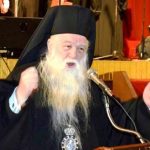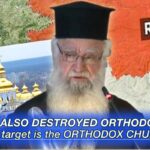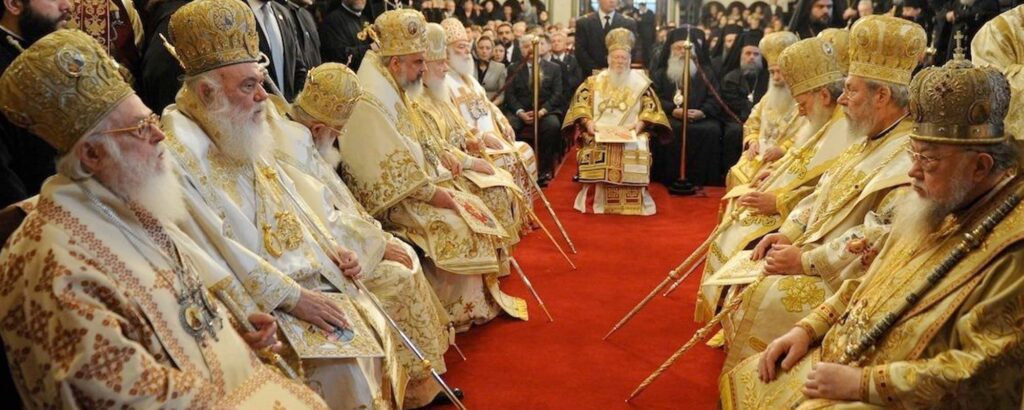
BISHOPS AND THEIR PARAPHERNALIA
This brief study consists primarily of a single long note “tucked away” in my book The Heavenly Banquet, Understanding the Divine Liturgy (364, pp. 129-31) combined with two short notes added to it (376, p. 134, and 1255, p. 359). The time has come for this material to be brought out in the open. Much more could be added and, especially, commented upon, and will be, in the Lord’s good time. For now I transfer this material from my book as is, save for a few sparse comments made here and there. The opening and concluding paragraphs are new. If you don’t have a copy of The Heavenly Banquet, visit Holy Trinity Monastery Church Supplies to purchase a copy.
[Ed. Note: I found a handwritten note of my dad’s that said the following: “I want to live and see the day when three bishops together will set aside all the paraphernalia of a Despot and will return to the polystavrion of St. John Chrysostom and all the Bishops of that blessed era ... I want to see the “thrones” sent to local museums, and if they don’t want them, to villagers who don’t have any wood to burn in wintertime. ... I want to live and see the bishops as celebrants which is their main function, with no “Eis polla eti, Despota” (many years, master).”]
Up until the 7th century, the Divine Liturgy began with the Entrance of the Gospel, with the people following behind the bishop who entered at this point, blessed the people, moved to his cathedra behind the altar, after putting on his vestments in the presence of the people.
The practice of bearing lights and censer before the bishop (as well as before the Gospel book and icons) is carried over from practices and observances in the ancient world, both civil and religious. Honorific lights and incense were carried before Roman magistrates.
In the days of St. John Chrysostom, the bishop blessed the people with a simple blessing. Today the bishop solemnly blesses the people with the dikērotrikēra—two sets of bundled candles, one with three, the other with two—which are said to signify respectively the three persons of the Holy Trinity and the two natures of Christ.
In hierarchal Liturgies the Trisagion (thrice-Holy Hymn) is chanted alternatively between chanters and clergy, in an elaborate version known as tou bematos, “from the bema.” It is extended through many repetitions, blessings, “many years,” praises of the hierarch (φήμη, phēmē), etc., which not only do not add meaning to the service, but detract from it, with various extraneous, human elements infiltrated over time, which burden the simplicity and sobriety of the service. Certainly here is a prime area, where a return to the simplicity of the ancient order would be most welcome by the people, whose patience is tested to the limit. This is supported by Metropolitan Augoustinos (Kantiotis) of blessed memory (+ 2010):
“It would be best if we limited these hymns [“Many Years” and phēmē], or even completely eliminate the “Many Years, Master.” The ideal of a Christian life is not length of years, but holiness and work for the glory of God.”
The bishop’s “throne” (cathedra) used to be behind the altar, in the middle of the synthronon, standing in place of God’s celestial throne. The Slavic churches have kept the synthronon behind the altar, and in many instances the cathedra is back in Greek churches as well.
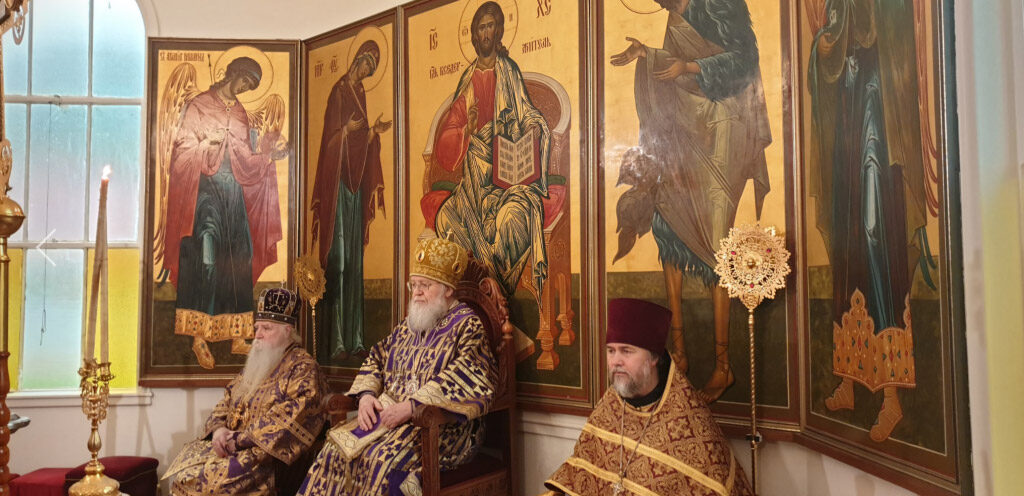
The “bishop’s throne” on the sōleas took the place of the emperor’s throne. It bears no resemblance to the bishop’s chair in the middle of the synthronon. The one is an image of God’s throne in heaven; the other, of the king’s throne on earth.
“With the public recognition of the Church in the fourth century, all the bishops found themselves enjoying the status of senior imperial officials. They soon came to be preceded, like their elder colleagues, by lights and incense when they made their official way to church. Like them, too, they wore the dress of the Roman upper classes, made obligatory for imperial officials by Theodosius I [d. 395 AD].” ... “Celestine I, Bishop of Rome in the early fifth century [+ 432 AD], insisted that it was by holiness rather than special adornment that bishops should be distinguished.”1
What would this holy Bishop of Rome say today about our bishops who sit on thrones reserved for the emperor, instead of their cathedra in the synthronon behind the Holy Table?2 The synthronon was in the sanctuary (hieron), where no layman, excepting the emperor, was allowed to enter. The “bishop’s throne” in the soleas took the place of the emperor’s throne. It bears no resemblance to the bishop’s chair in the middle of the synthronon. The one is an image of God’s throne in heaven; the other, of the king’s throne on earth.
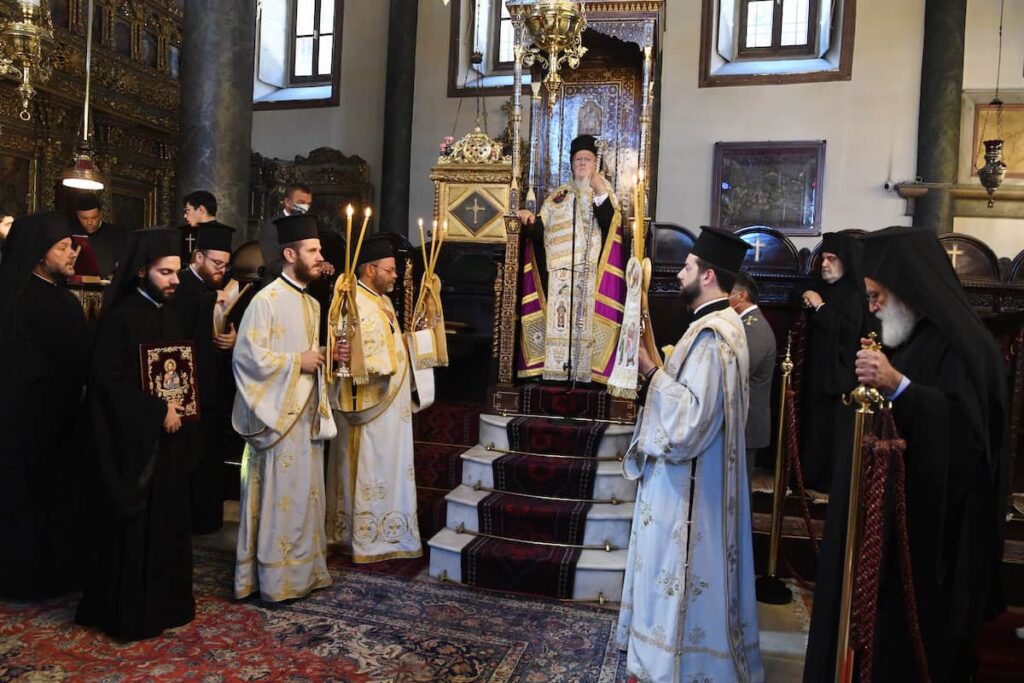
Today the bishops wear the Paleologian crown of the emperor and his imperial sakkos, instead of the polystavrion [a special phelonion embroidered with a pattern of multiple crosses], they wore until the fifteenth century; they hold the staff and the paraphernalia of worldly offices; and they accept the polychronia [“Many years!”] that belonged to them [emperors]. Let them listen to St. Germanos, Patriarch of Constantinople, when Constantinople was still in all its glory (A.D. 715-730):
“The double crown inscribed on the head of the priest through tonsure represents the precious head of the chief-apostle Peter. When he was sent out in the teaching and preaching of the Lord, his head was shaved by those who did not believe his word, as if in mockery. The Teacher Christ blessed this head, changed dishonor into honor, ridicule into praise. He placed on it a crown made not of precious stones, but one which shines more than gold, topaz, or precious stone—with the stone and rock of faith. Peter, the most-holy, the summit, beauty, and crown of the twelve stones, which are the apostles, is the hierarch of Christ.”3
“The use of the sakkos was a privilege bestowed by the Basileus [monarch] upon individual patriarchs as a sign of his personal favor. The first literary evidence for the garment is found in the writings of Balsamon, Patriarch of Antioch (ca. 1130–1140, d. after 1195). By the thirteenth century, however, it was worn by all patriarchs and some metropolitans, but only on Christmas, Easter and Pentecost. After the Fall of Constantinople in 1453, the sakkos replaces the polystavrion to become the Episcopal garment par excellence.”4
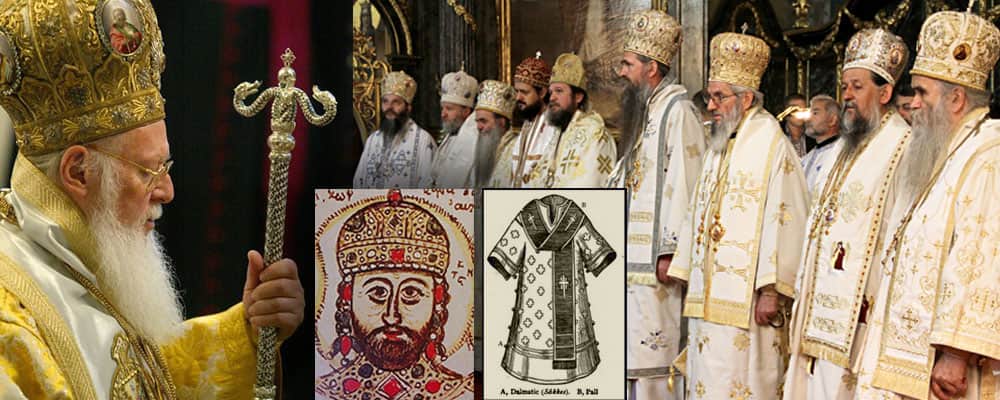
A crown was not placed on the heads of bishops probably until after the Fall of Constantinople (A.D. 1453).5 Until then only the Patriarch of Alexandria wore a simple cap, from about the tenth century on— the same time the western tiara first appeared. Even pope Benedict XVI (2005-2013) broke with established custom, by wearing at his inauguration as pope a modest, pointed mitre instead of the papal tiara (toll, three-tiered crown embedded with jewels).
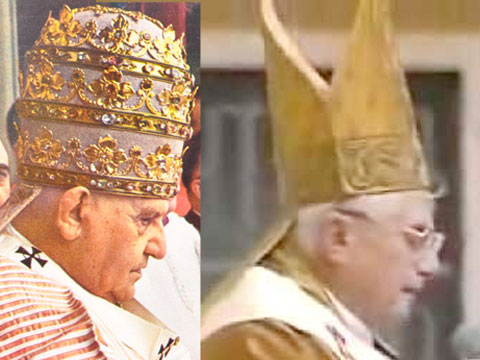
St. Symeon of Thessalonica [† 1429] says that with the exception of the bishops of Rome and Alexandria all the other bishops conducted the services and prayed with their heads uncovered, because they have Christ as their head. He quotes St. Dionysius saying,
“We do not receive a mitre on our heads when we are ordained,” as our head covering is the grace of the Holy Spirit, the same that sat on the heads of the holy Apostles.6
Contemporary Orthodox bishops have voiced similar views: Archbishop Christodoulos of Greece, of blessed memory († 2008), during a speech given in a televised Liturgy on Feb. 20, 2005, announced that the Synod of the Church of Greece, in its Feb. 19, 2005 session, decided to make the vestments of the bishops simpler, in order not to scandalize the people.
Also Metropolitan Hierotheos of Nafpaktos in a letter addressed to the Synod of the Church of Greece recommended as first steps a number of reforms, including the wearing of a crown and a staff only by the presiding bishop during co-celebrations and their optional use when celebrating away from their See.7
The Synod of the Church of Greece sent an encyclical,8 in which the bishops are asked to exhibit a “Christ-like ecclesiastical authenticity” in their behavior, but also in their dress code: not to dress “in gold or pearls or costly attire” (1 Tim. 2:9) or be “clothed in purple and fine linen” (Lk. 16:19) (the biblical references are made in the encyclical).9
The people are scandalized by the luxurious, heavily embroidered in gold, silk vestments, especially of the hierarchs, as it has been pointed out by Prof. Constantine Kalokyris in his article, “The External and Teletourgical Vestments of the Sacred Clergy.”10
The bishops should descend from their thrones, which don’t belong to them, and return to their place, the Synthronon, together with their fellow presbyters – the forgotten “honorable presbytery” – after shedding their vain paraphernalia: the imperial sakkos, tiaras, crosiers, pectoral crosses (double and triple) and other conceited insignia, and the Tyrian purple cloak (μανδύα), which by law only the Roman emperor could wear as symbol of his office.
The powerful emperors and kings are gone, but the Church Despots hold a tight grip on their pretentious, vainglorious, ostentatious and scandalous paraphernalia that do not belong to them, and, if they did in the past, they have outlived their lifespan. Aren’t they ashamed to stand next to their Roman Catholic and Episcopalian “brethren” who have shed whatever high-priestly insignia they used to have, appearing in simple dress next to them? It seems the crowns our bishops wear on their heads have gone to their heads.
We will be posting a follow up article with the more important aspect of the bishops: their place and role in the Church, their authority and how it is exercised, and their relation with the presbyters.
APPENDIX
Abbot Tryphon:
“Our bishops need to put off all pretensions and princely ways, and give themselves over to being loving fathers to their Priests and people. Our bishops need to lead their dioceses with biblical standards based on Love of their people, and Love of Christ, and not rule by fear and tyranny. Priests need to lead their people as loving Fathers, and not as local governors appointed by a Caesar.
We are living in dangerous times, and the people of God must be given the spiritual tools needed to thrive as our society falters, and Christians find themselves under increased attack. The road ahead requires bishops and priests to be more than religious officials, but holy men who lead their people as loving, caring, and merciful pastors.”
Metropolitan of Nafpaktos Hierotheos:
“The Bishop is the visible head of the Church, of the Body of Christ. He is the one who will speak the word of truth and be the criterion of truth. The sacred Canons, therefore, regard the Bishop as the eye of the Church. The Bishop is obliged to lead and teach his flock, including the monks, on the basis of the ecclesiastical tradition, so that they may walk in the way of salvation.” (Orthodox Monasticism As the Way of Life of Prophets, Apostles, and Martyrs)
If I had his Eminence present, I would ask him the following questions on the above teaching of his:
- There are many bishops, so you must mean the bishop of Rome to be the head of the visible Church, right?
- If you don’t mean him, but you refer to all bishops, then we have as many Churches as we have bishops, right?
- If each bishop is the visible head of the Church, since the Church is the body of Christ, then He must have as many bodies, as Bishops, right?
- Perhaps, by “Bishop” you must mean the Pope. After all, the Roman Catholics use his terminology, “visible vrs. invisible Church”, of the first one the Pope being the head and of the second Christ. Fair division, don’t you think?
- Seriously now, Christ founded only one Church, and that Church was, is and remains visible, if not to us, for sure to Him.
So, I don’t agree with Bishop Hierotheos. “Visible head”, visible and invisible Church bring to mind the Papist dogma. I also do not know of any Canon that calls the Bishop “the eye of the Church” - whatever that means. And to close, the people are not the Bishop’s flock, but Christ’s: “For you were as sheep going astray; but are now returned unto the Shepherd and Bishop of your souls.” (1 Peter 2:25, KJV:) I think that the Apostle by “Bishop” means Christ...
Fr. John Romanides (+ 2001):
“The catholicity of the Church is expressed by each local Church. Each part is the whole. This is also done in the Sacrament of the Holy Eucharist. When we partake of a “pearl” (a part of the Eucharistic Bread), then we partake of the whole Christ. The same thing happens with the Church, which is the Body of Christ.
Each local Church is the whole Church in miniature. Of course, this means that every local Church, in order to be catholic, must save ‘all the truth’ and every action that confirms the truth and leads to its living.
In the ancient Church, when they spoke of the Body of Christ and of Christ as the Head of the Church, they did not mean that Christ is physically spread throughout the world..., but that the entire Christ exists in each local Church with all her members, that is the Saints and the faithful of the world.
Thus, according to the teaching of the Fathers, when we celebrate the Divine Eucharist, not only Christ is present, but also all the Saints, just as the Christians of the whole world are also present. And when we partake of a small piece of Holy Bread, we receive the whole Christ within us. When the Christians gather together in one place, the entire Church gathers together and not a part of Her. For this reason in the patristic tradition the sanctuary of a Monastery is called “Catholicon”, where the whole Church is present.
(From “The One, Holy, Catholic and Apostolic Church: Where is Christ and how does He save?” Original article here. Parts of it are also in An Outline of Orthodox Patristic Dogmatics, pp. 77, 79.)
- Hugh Wybrew, The Orthodox Liturgy (St. Vladimir’s Seminary Press, Crestwood, New York 1966), pp. 32, 33. See also J. A. Jungmann, Missarum Solemnia, I (Freiburg 1952), p. 51, note 21, transl. F. A. Brunner, The Mass of the Roman Rite, New York 1951.
- Synthronon literally means, the “[seats] together with the throne [of the bishop].” It consists in a tiered row of seats forming a semicircle in the apse behind the altar, with the bishop’s throne at its centre. The clergy sat on the synthronon during the service.
- St. Germanus, of Constantinople, The Ecclesiastical History and Mystical Contemplation § 13 (see, On the Divine Liturgy, translated [with original Greek parallel text] by Paul Meyendorff (Crestwood, NY, 1984), p. 65.
- http://www.metmuseum.org/explore/byzantium_III/glossary_s.html.
- “The Byzantine Imperial Paradigm and Eastern Liturgical Vesture,” by Arthur E. John González, in The Greek Orthodox Theological Review, vol. XVII, No. 2, Fall 1972, Holy Cross School of Theology, Hellenic College, Brookline, Mass., pp. 255-267. Professor Protopresbyter Theodore Zeses calls the episcopal crown “anti-traditional” (Orthodoxos Typos, October 6, 2006, p. 3).
- “Answers to Certain Questions,” Questions 16 and 17, The Works, pp. 359-360.
- Orthodoxos Typos, April 1, 2005, p. 3.
- No. 28250, dated Nov. 29, 2005.
- Orthodoxos Typos, No. 1623, Dec. 16, 2005.
- Anaplasis, Nos. 421 and 422, Jan.-Feb. 2006 and March-April 2006.
Last edited by Fr. Emmanuel Hatzidakis (+2024) in January, 2024. Edited by Anthony Hatzidakis, March 8, 2024.

